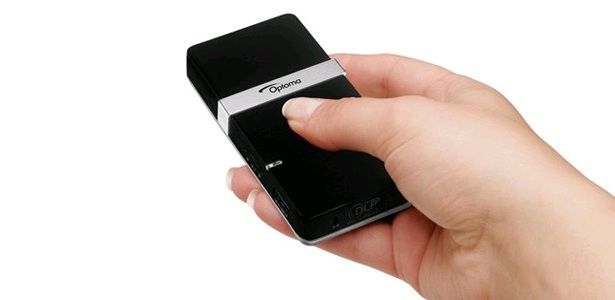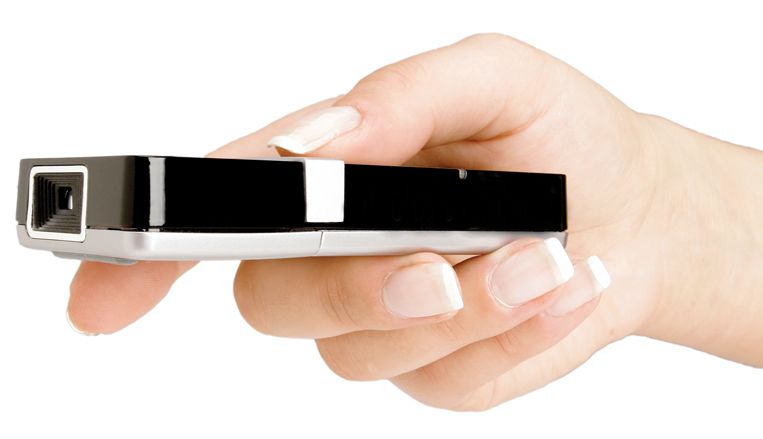Even if you have home cinema ambitions and deep pockets, there's no denying that projectors are just too cumbersome for many. Optoma's latest pocket-sized LED projector might promise great things for home entertainment in the long run, but for now this second-gen device is just not up to the demands of home cinema.
Our quick take
Last year's Pico PK101 had a paltry light output of 20 ANSI Lumens, and we'd wager that hasn't increased by much in this refreshed model. Built-in storage and a VGA input has been added, but there are problems with the user interface that do make this portable projector feel cumbersome. Used in a blackout pictures hold up well at around the 30-inch size, but it must be totally dark; DLP Pico technology still has a long way to go before it becomes anything like an essential gadget.

Optoma Pico PK102 pico projector - 3.0 / 5
| FOR | AGAINST |
|---|---|
|
|
If you're out and about giving business presentations, however, the idea of a genuinely portable projector will appeal, and the mobile phone-sized Pico is initially hugely impressive.
Its chief attraction isn't its tiny size, but the ability to store 4GB of files on the gadget itself. What other projector - of any size - can do that? What's more, the Optoma claims a huge file compatibility list that doesn't just cover the basics. For images, the Pico plays JPG, TIFF, GIF, PNG, BMP, TGA, FPX, PCX, PCD and PSD, though it doesn't play any music files despite having a 0.5W speaker.
On the video side, the Pico claims to play AVI, WMV, ASF, 3GP, 3G2, DAT, MPG, MPEG, MOV, MP4, M4V, RM, RMVB, OGM and FLV files. However, there's a huge caveat; absolutely everything - including PowerPoint presentations - have to be converted using ArcSoft Media Converter software that's supplied in the projector's memory itself. There's worse news, however - it only works with a PC, not on a Mac. That's unusual these days, and surprising since this product is being sold on Apple's website as a bona fide accessory for Apple products.
The Pico does, however, come with a few cables that mean external devices can be manually attached - a messy situation, and the only option for those with Apple devices (even then, a separate MiniDisplay port to VGA adapter and a VGA cable must be bought for Macs, or a separate iPod connection kit). In the box cables are supplied for Composite video, Component video and VGA, so it's possible to attach almost anything; we'd wager the Composite video will be most useful for its compatibility (with the adaptor) for iPhones and iPods, camcorders, laptops, games consoles, DVD players and cameras.
There's no doubting the Pico's svelte design; somehow Optoma has packed-in a wheel for operating the menus, a tiny focus wheel and speaker near the lamp, a slot for a tripod - a seemingly essential accessory, though not supplied in the box - and its proprietary VGA/USB slot and minijack AV slot.
Switch on the Pico and you're presented with a very simple menu with icons for Video, Pictures and Presentations. Click into each one and a list is presented of all the files, though it's very basic.
During our tests the menus frequently froze. A separate folder dragged into the Photos folder on the Pico refused to display - all files must seemingly be placed "loose" on the projector, though its ability to play slideshows might appeal.
If you're using an external video source, you can bypass all of this, though it's best to dive into the Settings menu first to make sure the Pico is on full brightness - its Eco setting isn't recommended.
The Pico's performance with video is just about acceptable, though you'll need a total blackout and a rather short film. We managed to play a video from a DVD player for just under an hour (on full brightness), though its 480 x 320 resolution, projected onto a screen in a 40-inch size from around 7 feet away (any bigger means a duller, lifeless and soft picture). Colour consequently drains out of the picture, while at other times some colours are over saturated.
To recap
Used in a blackout, pictures hold up well at around the 30-inch size, but it must be totally dark; DLP Pico technology still has a long way to go before it becomes anything like an essential gadget

